Two Century Interplanetary Rally
A couple of months ago, NASA published a triumphant infographic that stated that the Opportunity rover stepped over another interplanetary boundary in terms of travel distance and was ready to take first place. The second position for a long time was held by the Moon Buggy rover on which Apollo-17 pilots cut through the Moon. They dashed off 35.6 km in three days. Opportunity took nine years to get around its American rival.
And now, as if in the old "good" times of the Cold War and the space race, two nations entered the fierce struggle for leadership positions: the United States and the USSR.
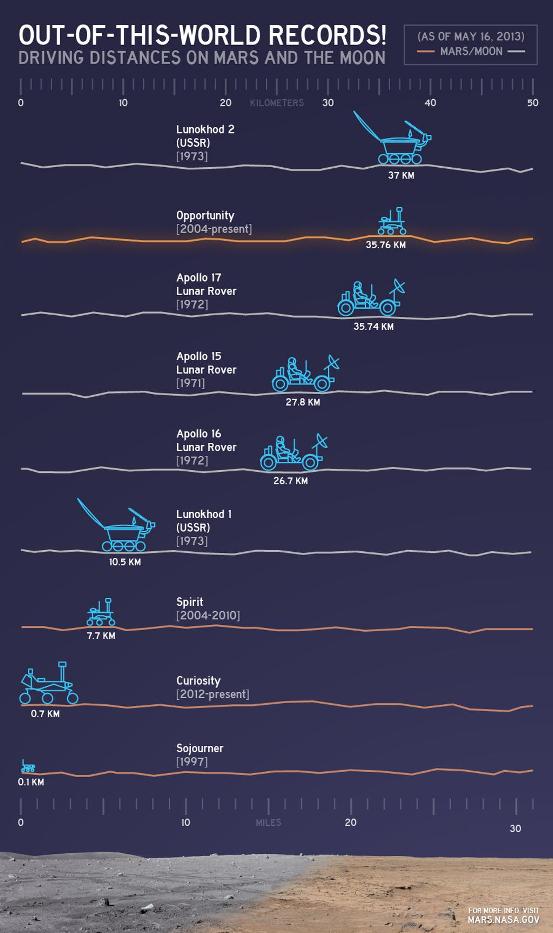
In May, NASA directed its rover from one studied mountain to another, much higher and more interesting. Between them two kilometers, and, it seemed, a little more, like a lunar Soviet old man, stalled forty years ago, will yield to his Martian rival.
But Opportunity exceeded the treasured 37 km and ... silence. Neither the jubilant parades in Washington, nor the boots of the chairmen of the Politburo of the Central Committee of the CPSU knocking with frustration on the stands.
And the secret of such silence from NASA is in the ninth wheel.
Everyone seems to know that the Opportunity has six wheels, and the Lunokhods have eight. But formally the Lunokhods had nine wheels each. Ninth is a thin odometer roller that rolled across the surface of the moon and measured the distance traveled.

The official figures, published at the end of the scientific mission of Lunokhod-2, and for a long time wandered from scientific works to textbooks, and from textbooks to Wikipedia, are based on the testimony of this odometer. But the fact is that the roller rose when Lunokhod-2 was moving backwards. The roller did not transmit the objective distance when the device was maneuvering, and by itself could slip on too loose soil.

As a result, the most objective means of determining its mileage could only be direct observation of the traces on the surface of the moon. Fortunately, today, scientists, and any of us, have such an opportunity thanks to the LRO spacecraft. Its LROC high-resolution camera is second only to the HiRise camera of its Martian fellow MRO. But thanks to the orbit, several times lower, LROC is capable of transmitting images almost similar in detail: in exceptional cases, up to 20 cm per pixel, but in the main mode of operation - 50 cm per pixel. This is quite enough to detect the Moon-21 on the Earth’s natural satellite, which delivered the Lunokhod-2 to the surface,

and, in fact, the nine-wheeled vehicle itself. True, for him, the LRO was halved and shot with detail of 30 cm per pixel:

Full size.
Find Lunokhod-2 yourself .
The discovery of Lunokhod-2 in LROC images is connected with a no less exciting story than with Mars-3 : first they found, but not that, then they looked closely and found that, and then they shone there with a laser and received an answer from optical corner reflectors.
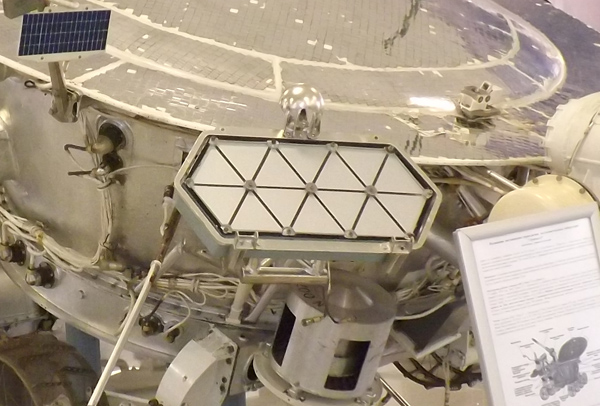
Russian scientists from Moscow State University of Geodesy and Cartography (MIIGAiK) carefully tracked the entire Lunokhod-2 route and determined its mileage of 42.2 kilometers. That is, due to an imperfect means of determining the distance traveled, more than 5 kilometers were missed. It’s difficult to name the exact figures up to a meter now.
The methods for measuring the distance traveled by Mars rovers are fundamentally different. They use a complex system to calculate mileage, which includes a three-axis accelerometer and a three-axis level sensor.

The readings of these sensors are taken into account when calculating mileage based on wheel speed. But even so easy to make mistakes due to slippage. And Opportunity had a lot of them for a century:
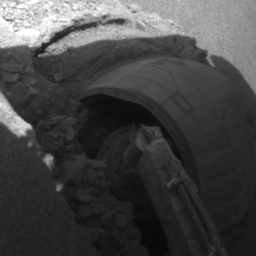
The main tool for calculating the mileage of rovers is called VisOd: visual odometry. If you look at the pictures of their tracks, you can notice the heterogeneity of the track left by the tread. Direct notches that differ from the main picture - these are markers for visual odometry.
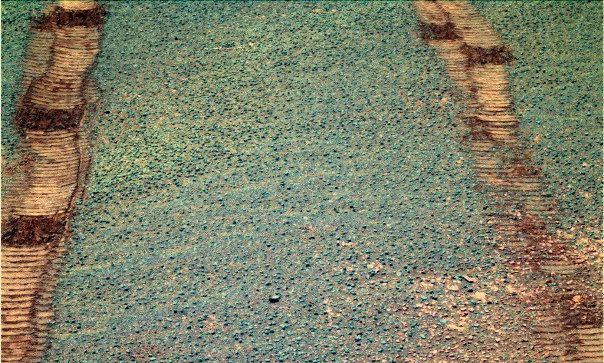
The same principle applies to Curiosity. And the mileage is considered by the program, but its indications can be periodically controlled manually. Among other things, Curiosity marks its mark with Morse code “JPL”, so its mileage can be counted in meters, feet and in jeeps. (More on calculating Spirit mileage )

Let's go back to Lunokhod-2.
For some, a new result, and the primacy of the domestic product in the interplanetary rally, may be cause for pride. But we must remember that both moon rovers and rovers were created primarily for the study of foreign bodies, and not for wrapping odometers.
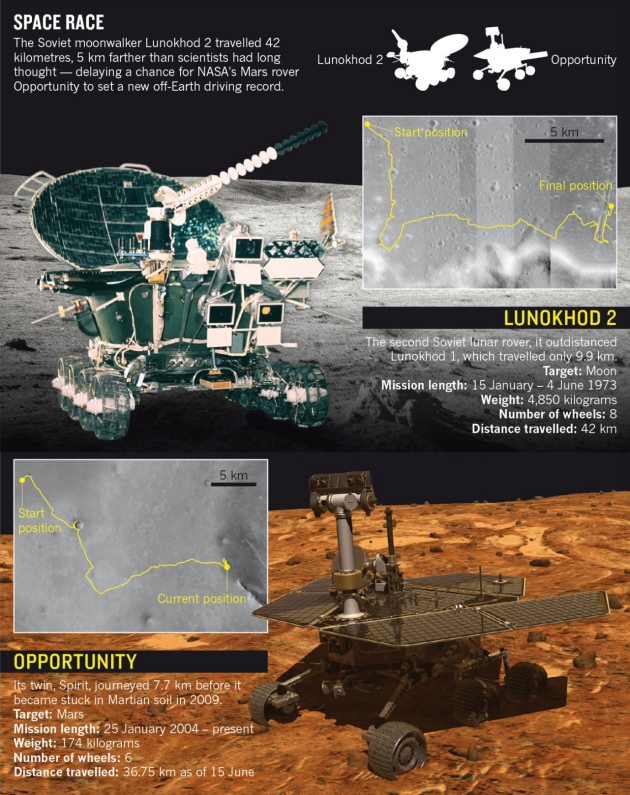
The problem is that the party leadership of the USSR looked only at odometers. The ideological machine that operated with the concepts of “catch up and overtake” was unable to understand the concepts of “learn and re-learn.” Alexander Bazilevsky, professor of the Geochemistry Institute of the Russian Academy of Sciences, who also helped in the search for Lunokhod-2 and Mars-3, described events like this: “As soon as the Lunokhod came across an interesting stone and geologists asked to stop in order to examine it in more detail, the management stated:“ This is a Lunokhod , not a lunostop. Only forward!"
Mars rovers are controlled by geologists. This explains that Curiosity, worked twice as long as Lunokhod-2, but drove almost fifty times less. Yes, and rally success Opportunity - is the result of his research activities. He overcame about half of the total mileage only by crossing uninteresting open spaces that had already been well studied.
In the museum of NGOs named after S.A. Lavochkina is Lunokhod-3. This is not a mock-up, but a real apparatus that took into account all the “childhood illnesses” of its predecessors, had rotary stereo cameras and not photometers, had a full range of research instruments, passed all the tests and was ready to conquer the lunar expanses.

But the party had already played enough in "moon tractors", so the "Russian Curioisty" was forever frozen on the Moon-25 ramp in the hall, where only a few visitors can get due to restricted access to the sensitive facility.
I express gratitude to the leadership of the NGO named after S.A. Lavochkina for the opportunity to visit this small but interesting museum for a fan of robotic astronautics.
And now, as if in the old "good" times of the Cold War and the space race, two nations entered the fierce struggle for leadership positions: the United States and the USSR.

In May, NASA directed its rover from one studied mountain to another, much higher and more interesting. Between them two kilometers, and, it seemed, a little more, like a lunar Soviet old man, stalled forty years ago, will yield to his Martian rival.
But Opportunity exceeded the treasured 37 km and ... silence. Neither the jubilant parades in Washington, nor the boots of the chairmen of the Politburo of the Central Committee of the CPSU knocking with frustration on the stands.
And the secret of such silence from NASA is in the ninth wheel.
Everyone seems to know that the Opportunity has six wheels, and the Lunokhods have eight. But formally the Lunokhods had nine wheels each. Ninth is a thin odometer roller that rolled across the surface of the moon and measured the distance traveled.

The official figures, published at the end of the scientific mission of Lunokhod-2, and for a long time wandered from scientific works to textbooks, and from textbooks to Wikipedia, are based on the testimony of this odometer. But the fact is that the roller rose when Lunokhod-2 was moving backwards. The roller did not transmit the objective distance when the device was maneuvering, and by itself could slip on too loose soil.

As a result, the most objective means of determining its mileage could only be direct observation of the traces on the surface of the moon. Fortunately, today, scientists, and any of us, have such an opportunity thanks to the LRO spacecraft. Its LROC high-resolution camera is second only to the HiRise camera of its Martian fellow MRO. But thanks to the orbit, several times lower, LROC is capable of transmitting images almost similar in detail: in exceptional cases, up to 20 cm per pixel, but in the main mode of operation - 50 cm per pixel. This is quite enough to detect the Moon-21 on the Earth’s natural satellite, which delivered the Lunokhod-2 to the surface,

and, in fact, the nine-wheeled vehicle itself. True, for him, the LRO was halved and shot with detail of 30 cm per pixel:

Full size.
Find Lunokhod-2 yourself .
The discovery of Lunokhod-2 in LROC images is connected with a no less exciting story than with Mars-3 : first they found, but not that, then they looked closely and found that, and then they shone there with a laser and received an answer from optical corner reflectors.

Russian scientists from Moscow State University of Geodesy and Cartography (MIIGAiK) carefully tracked the entire Lunokhod-2 route and determined its mileage of 42.2 kilometers. That is, due to an imperfect means of determining the distance traveled, more than 5 kilometers were missed. It’s difficult to name the exact figures up to a meter now.
The methods for measuring the distance traveled by Mars rovers are fundamentally different. They use a complex system to calculate mileage, which includes a three-axis accelerometer and a three-axis level sensor.

The readings of these sensors are taken into account when calculating mileage based on wheel speed. But even so easy to make mistakes due to slippage. And Opportunity had a lot of them for a century:

The main tool for calculating the mileage of rovers is called VisOd: visual odometry. If you look at the pictures of their tracks, you can notice the heterogeneity of the track left by the tread. Direct notches that differ from the main picture - these are markers for visual odometry.

The same principle applies to Curiosity. And the mileage is considered by the program, but its indications can be periodically controlled manually. Among other things, Curiosity marks its mark with Morse code “JPL”, so its mileage can be counted in meters, feet and in jeeps. (More on calculating Spirit mileage )

Let's go back to Lunokhod-2.
For some, a new result, and the primacy of the domestic product in the interplanetary rally, may be cause for pride. But we must remember that both moon rovers and rovers were created primarily for the study of foreign bodies, and not for wrapping odometers.

The problem is that the party leadership of the USSR looked only at odometers. The ideological machine that operated with the concepts of “catch up and overtake” was unable to understand the concepts of “learn and re-learn.” Alexander Bazilevsky, professor of the Geochemistry Institute of the Russian Academy of Sciences, who also helped in the search for Lunokhod-2 and Mars-3, described events like this: “As soon as the Lunokhod came across an interesting stone and geologists asked to stop in order to examine it in more detail, the management stated:“ This is a Lunokhod , not a lunostop. Only forward!"
Mars rovers are controlled by geologists. This explains that Curiosity, worked twice as long as Lunokhod-2, but drove almost fifty times less. Yes, and rally success Opportunity - is the result of his research activities. He overcame about half of the total mileage only by crossing uninteresting open spaces that had already been well studied.
In the museum of NGOs named after S.A. Lavochkina is Lunokhod-3. This is not a mock-up, but a real apparatus that took into account all the “childhood illnesses” of its predecessors, had rotary stereo cameras and not photometers, had a full range of research instruments, passed all the tests and was ready to conquer the lunar expanses.

But the party had already played enough in "moon tractors", so the "Russian Curioisty" was forever frozen on the Moon-25 ramp in the hall, where only a few visitors can get due to restricted access to the sensitive facility.
I express gratitude to the leadership of the NGO named after S.A. Lavochkina for the opportunity to visit this small but interesting museum for a fan of robotic astronautics.
